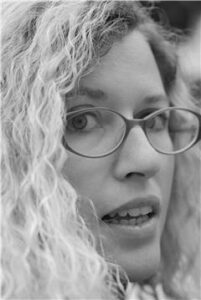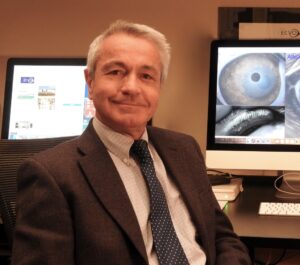Our animal friends, so precious and irreplaceable in all the good and bad moments of our lives.
We wanted to dedicate a special space to them and the health of their eyes, in which highly qualified professionals describe the pathologies that can affect them and how they should be treated.
 To this end, we contacted Prof. Chiara Giudice, who teaches General Pathology and Veterinary Pathological Anatomy-Oncology in the Department of Veterinary Medicine and Animal Sciences (DIVAS) in Milan, and also holds the position of President of SOVI (Society of Italian Veterinary Ophthalmology - SCIVAC)
To this end, we contacted Prof. Chiara Giudice, who teaches General Pathology and Veterinary Pathological Anatomy-Oncology in the Department of Veterinary Medicine and Animal Sciences (DIVAS) in Milan, and also holds the position of President of SOVI (Society of Italian Veterinary Ophthalmology - SCIVAC)
Prof. Giudice will be the coordinator of our column, which will feature articles, interviews and clinical cases.
Let's give you the floor to begin with!
"For almost 25 years now, I have been involved in a somewhat special branch of veterinary pathology, ocular pathology. I started with my doctorate, many years ago, and have never stopped. 
I had more than one mentor, but among them Claudio Peruccio certainly played a prominent role. Presenting Claudio, Professor Peruccio, is a difficult role: his CV is endless, he was one of the founding fathers of veterinary ophthalmology not only in Italy, but also in Europe, and his role has also been officially recognised by the American College of Veterinary Ophthalmologists (ACVO), which awarded him the title of honorary ACVO Diplomate. However, when I am the 'chairman' at some congress and I have the opportunity, I like to present him in a slightly different way, the way I am presenting him to you today: to get to know Claudio's curriculum vitae you only have to Google him (and have a little time to read). More fortunate are those who have the opportunity to get to know him and listen to him: to them is reserved the discovery of an uncommon quality, that of a man who, despite having all the possible recognition, never, never stops studying, renewing himself, discovering new frontiers. It is a rare quality, really, and for all of us who are involved in ophthalmology it is a constant stimulus to learn, without ever sitting back on our achievements even if keeping up with them, believe me, is difficult even for the 'younger' ones. It is therefore an honour for me to open this column today with your testimony."
A bit of history
Veterinary ophthalmology has a long tradition, little known to the layman.
Documents dating back to ancient Egypt describe the most frequent eye diseases that restricted the use of animals that had to perform work, such as cattle, or that, like horses, were the main means of locomotion in existence. But oculopathies of affection animals are also mentioned on ancient papyri.
As far as modern history is concerned, the study of animal eye diseases was consolidated in Europe and the United States until the birth of the American 'College' (ACVO) in 1970, the European 'College' (ECVO) in 1992 and gradually those of Australia and New Zealand (ANZCVS-OC), Latin America (CLOVE), Brazil (CBOV) and Asia (AiCVO). The members of each College are specialists in the field, involved in university or freelance work, who have had the opportunity to devote many years to study and pass demanding examinations in order to acquire the title. Some work in research centres to identify and select animal models of spontaneous diseases useful for humans.
Other veterinary physicians have developed a specific interest in veterinary ophthalmology, forming national professional associations with intensive continuing education activities. Internationally, the ISVO was created in 1980, linking experts in the subject from all over the world. The organisation of refresher courses, national and international congresses and the creation of intermediate diplomas has enabled the further development of the field, so that today many veterinary surgeons devote themselves to ophthalmology, especially for pets.
On our initiative, the international journal Progress in Veterinary and Comparative Ophthalmology was founded in 1991. With the involvement of new editors, it has been published as Veterinary and Comparative Ophthalmology since 1994 and finally as Veterinary Ophthalmology from 1998 onwards.
Veterinary ophthalmology today
Today, the veterinary ophthalmologist examines the eyes of animals with the portable version of instruments used for humans. He performs surface surgeries on the ocular adnexa and cornea, but also intraocular surgeries such as cataracts and, in some cases, vitreo-retinal surgery.
The exponential increase in interest in affectionate animals has increased the demand for specialist services, which has led to the recognition of eye diseases that overlap with those of humans. Today, there are those who focus on diseases of the tear film and anterior segment, intraocular, retinal or neuro-ophthalmology.
For animals, too, progress has enabled the use of sophisticated imaging tools such as, for example, optical tomography, or therapy, such as, to name a recent one, cross-linking.
The need to breed animals free of hereditary ocular diseases has fostered studies in genetics and the emergence of a true specialist field with recognised experts in the field. It is an extremely important subject given the numerous hereditary oculopathies that afflict dogs and cats of all breeds. Licensed veterinary ophthalmologists carry out thorough examinations to select suitable subjects for breeding and issue certificates to breeders. Thanks to these studies, the number of disease carriers has drastically decreased and animal welfare is better protected.
For histopathological investigations, we rely on a limited number of pathologists with specific expertise in the field, to whom samples are sent nationwide for examination.
Prof. Claudio Peruccio
Veterinary Doctor, SCMPA, Hon Dipl ACVO, MRCVS
European EBVS® & RCVS Specialist in Veterinary Ophthalmology
In this section:
- The opaque eye: not only cataracts...
- Opaque eye: could it be glaucoma?
- Suspected glaucoma: no time to lose!
- Glaucoma: when medical therapy does not work...
